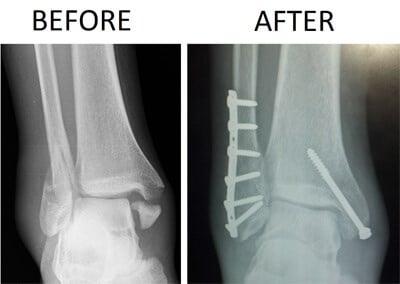WHAT IS AN ANKLE FRACTURE?
An ankle fracture is basically what we call a “broken ankle.” This means that one or more of the ankle bones are broken. There are two leg bones (the tibia and fibula) and one-foot bone (talus), which form the ankle. The most common type of ankle fracture is when the bone on the outside of the ankle (fibula) breaks. When a fracture occurs, the stability of the bone can become sacrificed, and the ankle may shift. This state is called “fracture dislocation” and may cause much more serious issues that need to be treated.
If you have experienced an ankle fracture and need treatment, Dr. Suzanne Levine and her team can evaluate the extent of your fracture and provide a procedure plan specifically for you. To learn more, contact Millennium Podiatry in New York, NY to schedule a consultation.
What are the SYMPTOMS of an ankle fracture?
Ankle fractures are divided into two main groups:
- Stable ankle fractures: The ankle joint remains intact
- Unstable ankle fractures: The ankle joint is dislocated
The symptoms vary depending on the extent of the injury. Extreme swelling and pain, in addition to the inability to walk, are major signs of a fracture. In surgical-emergency cases, the broken bone can pop out of the skin, or the swelling can cut off the blood circulation to the leg. Significant fractures may cause dislocation of the ankle. Less severe breaks may have mild pain/discomfort, and patients may be able to put some weight on their foot.
What CAUSES an ANKLE FRACTURE?
Most ankle fractures occur following an acute twisting injury, where the foot is planted on the ground, and the body rotates around it. Inversion injuries are also common, where the foot turns inward on the leg and fractures the outside ankle bone. Additional causes are slips, falls (especially when landing on one’s foot), and poor bone state.
Reviews
How is an ANKLE FRACTURE treated?
The type of ankle fracture treatment depends on the involved bone(s), fracture orientation, displacement, separation of the bones, the extent of damage, and the fracture’s/ankle’s stability.
The basis for ankle fracture surgery is to manually place the broken bone(s) in proper alignment. After, while bone healing takes place, we stabilize the fractured bones, often with screws and plates.
The location and orientation of the fracture generally determine the method and type of fixation used to fixate the bone. Stable ankle fractures can be treated without surgery by limiting activity until the bone has healed. Foot immobilization could be achieved by using either a boot or casts with (or without) crutches, depending on the severity of the fracture.
Most unstable ankle fractures benefit from surgery to stabilize the fractures and ensure that the joint heals in an anatomic position. With or without surgery, broken bones take 6 – 8 weeks to mend.

Ankle Fracture Treatment FAQ
What are the most common causes of an ankle fracture?
The most common causes of an ankle fracture include:
- Severe force applied to the ankle joint straight down (like jumping from a high level)
- Over-flexing or extending the joint
- Rolling the ankle (out or in)
Will I need surgery for a fractured ankle?
Most ankle fractures require surgery to place a plate with screws to stabilize the fractured bones and ensure the joint heals in an anatomically correct position.
How long does it take to recover from a fractured ankle?
The typical recovery time for a fractured ankle is about 6 – 8 weeks, during which time you may have to wear a boot or a cast. Normal activities can usually be resumed in about three months.
Receive Specialized Fracture Treatment
An ankle fracture can be both painful and lead to additional complications. If you have experienced an ankle fracture, it is important to seek evaluation and treatment as soon as possible. Contact our Park Avenue facility in New York, NY to learn more and to schedule a consultation.










